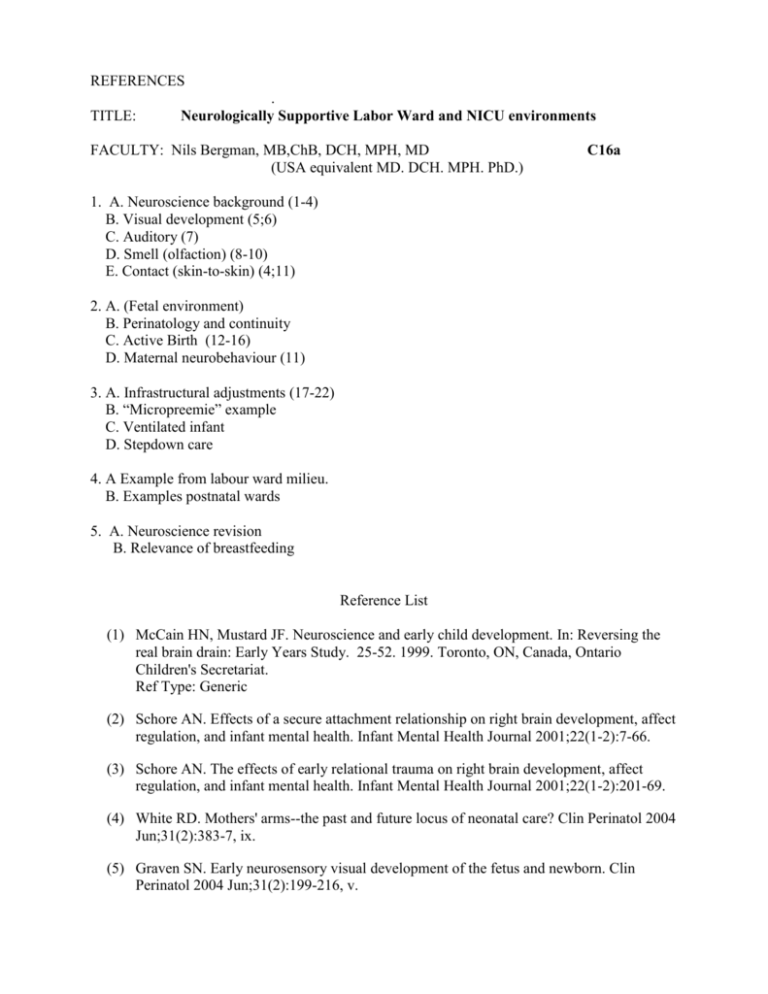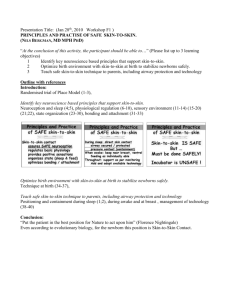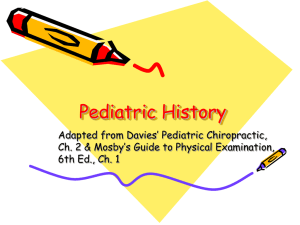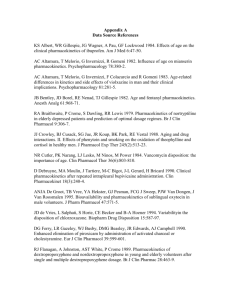Reference - Skin to Skin Contact
advertisement

REFERENCES TITLE: . Neurologically Supportive Labor Ward and NICU environments FACULTY: Nils Bergman, MB,ChB, DCH, MPH, MD (USA equivalent MD. DCH. MPH. PhD.) C16a 1. A. Neuroscience background (1-4) B. Visual development (5;6) C. Auditory (7) D. Smell (olfaction) (8-10) E. Contact (skin-to-skin) (4;11) 2. A. (Fetal environment) B. Perinatology and continuity C. Active Birth (12-16) D. Maternal neurobehaviour (11) 3. A. Infrastructural adjustments (17-22) B. “Micropreemie” example C. Ventilated infant D. Stepdown care 4. A Example from labour ward milieu. B. Examples postnatal wards 5. A. Neuroscience revision B. Relevance of breastfeeding Reference List (1) McCain HN, Mustard JF. Neuroscience and early child development. In: Reversing the real brain drain: Early Years Study. 25-52. 1999. Toronto, ON, Canada, Ontario Children's Secretariat. Ref Type: Generic (2) Schore AN. Effects of a secure attachment relationship on right brain development, affect regulation, and infant mental health. Infant Mental Health Journal 2001;22(1-2):7-66. (3) Schore AN. The effects of early relational trauma on right brain development, affect regulation, and infant mental health. Infant Mental Health Journal 2001;22(1-2):201-69. (4) White RD. Mothers' arms--the past and future locus of neonatal care? Clin Perinatol 2004 Jun;31(2):383-7, ix. (5) Graven SN. Early neurosensory visual development of the fetus and newborn. Clin Perinatol 2004 Jun;31(2):199-216, v. (6) Rivkees SA. Emergence and influences of circadian rhythmicity in infants. Clin Perinatol 2004 Jun;31(2):217-vi. (7) Gray L, Philbin MK. Effects of the neonatal intensive care unit on auditory attention and distraction. Clin Perinatol 2004 Jun;31(2):243-60, vi. (8) Schaal B, Hummel T, Soussignan R. Olfaction in the fetal and premature infant: functional status and clinical implications. Clin Perinatol 2004 Jun;31(2):261-vii. (9) Varendi H, Porter RH, Winberg J. Natural odour preferences of newborn infants change over time. Acta Paediatr 1997 Sep;86(9):985-90. (10) Varendi H, Porter RH. Breast odour as the only maternal stimulus elicits crawling towards the odour source. Acta Paediatr 2001 Apr;90(4):372-5. (11) Browne JV. Early relationship environments: physiology of skin-to-skin contact for parents and their preterm infants. Clin Perinatol 2004 Jun;31(2):287-98, vii. (12) Kennell JH, Klaus MH. The perinatal paradigm: is it time for a change? Clin Perinatol 1988 Dec;15(4):801-13. (13) Klaus MH, Jerauld R, Kreger NC, McAlpine W, Steffa M, Kennel JH. Maternal attachment. Importance of the first post-partum days. N Engl J Med 1972 Mar 2;286(9):460-3. (14) Klaus MH, Kennell JH. Maternal-Infant Bonding. St Louis, MO.: C.V. Mosby; 1976. (15) Odent MR. In praise of the traditional birth attendant. Lancet 1989 Oct 7;2(8667):862-3. (16) Odent MR. Position in delivery. Lancet 1990 May 12;335(8698):1166. (17) Johnson BH, Abraham MR, Parrish RN. Designing the neonatal intensive care unit for optimal family involvement. Clin Perinatol 2004 Jun;31(2):353-82, ix. (18) Philbin MK. Planning the acoustic environment of a neonatal intensive care unit. Clin Perinatol 2004 Jun;31(2):331-52, viii. (19) White RD. Lighting design in the neonatal intensive care unit: practical applications of scientific principles. Clin Perinatol 2004 Jun;31(2):323-30, viii. (20) Smith J, Bajo K, Hager J. Planning a developmentally appropriate neonatal intensive care unit. Clin Perinatol 2004 Jun;31(2):313-viii. (21) Shepley MM. Evidence-based design for infants and staff in the neonatal intensive care unit. Clin Perinatol 2004 Jun;31(2):299-311, vii. (22) Rea M. Lighting for caregivers in the neonatal intensive care unit. Clin Perinatol 2004 Jun;31(2):229-42, vi.







